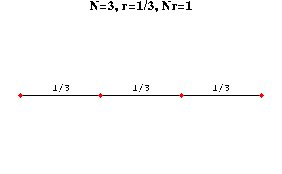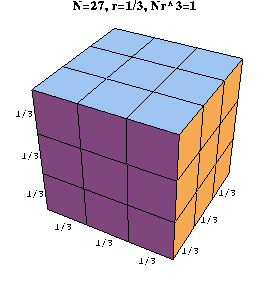Consider a line segment divided into N equal pieces. Each of these N pieces can be thought of as a scaled version of the whole segment, with scaling ratio r=1/N. The relation between N and r is clearly Nr=1. For example, if N=3, then r=1/3 and Nr=(3)(1/3)=1. (See the figure generated by the cell below.)
Input :=
Clear[points,line,n]
points=ListPlot[{{0,0},{1/3,0},{2/3,0},{1,0}},
PlotStyle->{Red,PointSize[.02]},Axes->False,
DisplayFunction->Identity];
line=Graphics[Line[{{0,0},{1,0}}]];
Show[{line,
points,
Graphics[Table[
Text["1/3",{n,.01}],{n,1/6,5/6,1/3}]]},
PlotLabel->FontForm["N=3, r=1/3, Nr=1",
{"Times-Bold",14}],
PlotRange->{-.1,.1},
DisplayFunction->$DisplayFunction]

Output = -Graphics-
Now suppose the sides of a square are scaled by a factor r to produce N identical subsquares, each of which is a scaled version of the whole square. The relation between N and r in this case is Nr2=1. For example, if r=1/3, then N=9 and Nr2=(9)(1/9)=1. (See the figure generated by the cell below.)
Input :=
Clear[i,j,n,horizontal,vertical]
horizontal=Table[Graphics[Line[{{0,j},{1,j}}]],
{j,0,1,1/3}];
vertical=Table[Graphics[Line[{{i,0},{i,1}}]],
{i,0,1,1/3}];
Show[{
horizontal,
vertical,
Graphics[Table[
Text["1/3",{-.05,n}],{n,1/6,5/6,1/3}]],
Graphics[Table[
Text["1/3",{n,-.05}],{n,1/6,5/6,1/3}]]},
AspectRatio->1,
PlotLabel->FontForm["N=9, r=1/3, Nr^2=1",
{"Times-Bold",14}]]

Output = -Graphics-
Finally, if a cube is scaled in the x, y, and z directions by a factor r to produce N equal subcubes, then the relation is Nr3=1. For example, if r=1/3, then N=27 and Nr3=(27)(1/27)=1. (See the figure generated by the cell below.)
Input :=
Clear[i,j,k,n]
Show[{
Table[Graphics3D[Cuboid[{i,j,k},
{i+1/3,j+1/3,k+1/3}]],
{i,0,2/3,1/3},{j,0,2/3,1/3},{k,0,2/3,1/3}],
Graphics3D[Table[
Text["1/3",{n,-.05,-.05}],{n,1/6,5/6,1/3}]],
Graphics3D[Table[
Text["1/3",{1.05,n,-.05}],{n,1/6,5/6,1/3}]],
Graphics3D[Table[
Text["1/3",{-.05,-.05,n}],{n,1/6,5/6,1/3}]]},
Boxed->False,
PlotLabel->FontForm["N=27, r=1/3, Nr^3=1",
{"Times-Bold",14}]]

Output = -Graphics3D-
The line, square, and cube above have integer dimensions of one, two, and three respectively. Notice that the dimensions of these objects show up as the exponent d in the relation Nrd=1, where N is the number of equal subunits and r is the scaling ratio. In general, if a given set is the union of N essentially disjoint copies of the original that are scaled by a constant factor r, then the value of d that satisfies the equation Nrd=1 is called the fractal dimension or similarity dimension of the set.
It turns out that there are configurations for which the value of d in Nrd=1 is not an integer. Such configurations are called self-similar fractals.
The explicit formula for d in terms or N and r is given by the cell below.
Input := Solve[n r^d==1,d]
Solve::ifun:
Warning: Inverse functions are being used
by Solve, so some solutions may not be
found.
Output =
1
Log[-]
n
{{d -> ------}}
Log[r]
The logarithm in the formula above can be taken with respect to any positive base different from 1. The following cell defines a function called dimension that takes the values of N and r as input and returns the value of d. This function will be used later in this notebook, so execute it now.
Input :=
Clear[dimension,d]
dimension[n_Integer?Positive,r_?Positive]:=
Module[{d},
d=Log[1/n]/Log[r]//N]